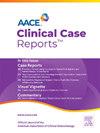多发性1型内分泌肿瘤和侵袭性胰腺神经内分泌肿瘤家族的新突变
IF 1.2
Q3 Medicine
引用次数: 0
摘要
背景:1型多发性内分泌瘤(MEN1)是一种罕见的常染色体显性遗传病,其特征是不同腺体(通常是甲状旁腺、胰腺和垂体)以及消化道其他部位的联合肿瘤。本研究描述了一个巴西MEN1家族的表型,该家族是由先前未报道的MEN1基因突变引起的。病例报告我们报告一例41岁男性先证者,其表现为血管纤维瘤、原发性甲状旁腺功能亢进、巨泌乳素瘤和胰腺神经内分泌肿瘤。对患者外周血DNA样本中MEN1基因的下一代测序分析显示16个碱基对的缺失(c.1366-12_1369del;p)导致框架错误。另外5名家庭成员(4名兄弟和1名表兄)表现出MEN1的临床特征。所有的兄弟都接受了突变筛查,结果显示相同的基因变异呈阳性。其中两人还被诊断为甲状腺乳头状癌。c.1366-12_1369del;p突变位于MEN 1基因的第10和最后一个外显子与其前面的内含子之间,包含剪接连接处的规范位点。MEN1的第10个外显子编码了最后163个氨基酸,这些氨基酸组成Menin蛋白的c端区域,该区域包含核定位信号,对于其内化到核室并与核基质相互作用至关重要。结论我们的病例报告增加了对MEN 1基因新的致病变异的描述。本文章由计算机程序翻译,如有差异,请以英文原文为准。
A Novel Mutation in a Family With Multiple Endocrine Neoplasia Type 1 and Aggressive Pancreatic Neuroendocrine Tumors
Background
Multiple endocrine neoplasia type 1 (MEN1) is a rare autosomal dominant disorder characterized by the occurrence of combined tumors in different glands, usually the parathyroid, pancreas and pituitary, as well as in other parts of the digestive tract. The present study describes the phenotype of a Brazilian family with MEN1 caused by a previously unreported MEN1 gene mutation.
Case Report
We report the case of a 41-year-old male, the proband, who presented with angiofibromas, primary hyperparathyroidism, macroprolactinoma, and pancreatic neuroendocrine tumor. Next generation sequencing analysis of the MEN1 gene in the patient's peripheral blood DNA sample revealed a deletion of 16 base pairs (c.1366-12_1369del;p) resulting in a framing error. Additional 5 members of the family (4 brothers and a first cousin) presented with clinical features of MEN1. All brothers underwent mutation screening and tested positive for the same genetic variant. Two of them were also diagnosed with papillary thyroid carcinoma.
Discussion
The c.1366-12_1369del;p mutation is located between the 10th and last exon of the MEN 1 gene and it's preceding intron, encompassing the canonical sites in the splice junction. The 10th exon of MEN1, possibly lost with this variant, encodes the last 163 amino acids that compose the Menin protein's C-terminal region, which harbors nuclear localization signals essential for its internalization into the nuclear compartment and interaction with the nuclear matrix.
Conclusion
Our case reports add to the literature the description of a new pathogenic variant of the MEN 1 gene.
求助全文
通过发布文献求助,成功后即可免费获取论文全文。
去求助
来源期刊

AACE Clinical Case Reports
Medicine-Endocrinology, Diabetes and Metabolism
CiteScore
2.30
自引率
0.00%
发文量
61
审稿时长
55 days
 求助内容:
求助内容: 应助结果提醒方式:
应助结果提醒方式:


